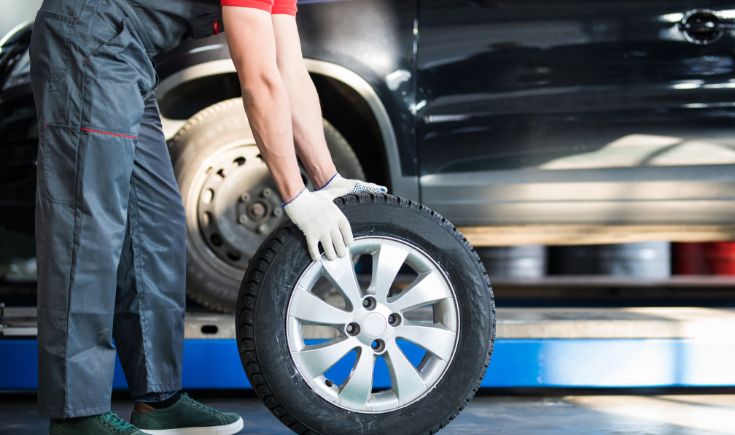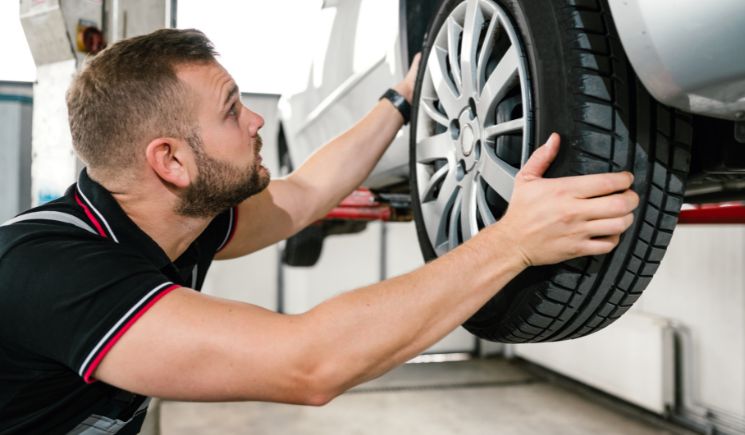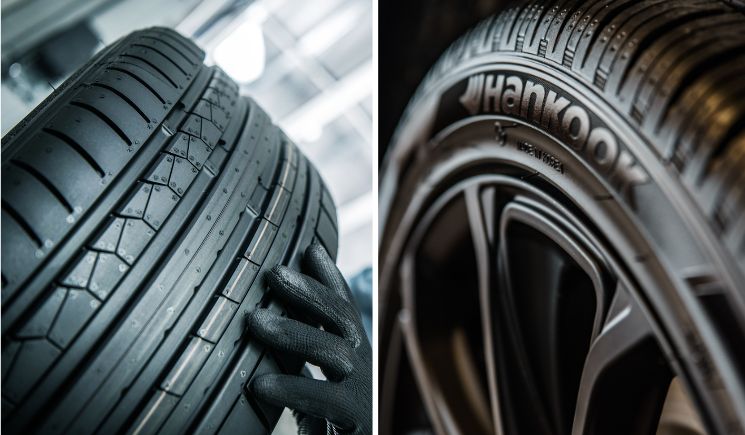Car Swaying After New Tires

Have you recently installed new tires on your car and noticed that it’s swaying more than usual?
You’re not alone. Many drivers have reported increased car sway after installing newer and higher performance tires, even if the same model had been used before without any issues.
It is important to understand why this problem may be occurring so that you can take steps to correct it.
In this article, we explore the potential causes of a car swaying after new tires are installed, as well as ways to fix the issue.
Table of Contents
- Causes Of Car Swaying
- Identifying Possible Causes
- Balancing And Alignment
- Tire Pressure Adjustments
- Upgrading Suspension Components
- Frequently Asked Questions
- Conclusion
Causes Of Car Swaying
As I cruised down the highway, my car started to sway from side-to-side and it felt like a roller coaster. It was a strange sensation as if something had changed in the way my car drove – but what?
Had I hit a pothole that caused some damage? Or maybe one of my tires were flat? These questions raced through my mind as I tried desperately to keep control of the wheel.
My heart pounded faster with each passing second as I slowly pulled over onto the shoulder. After coming to a stop, I stepped out of the car to inspect any possible causes for this sudden change in performance.
That’s when I noticed both rear tires had been replaced recently; could they be causing this issue? I inspected them further, looking for clues that could explain why my car was swaying uncontrollably just moments ago. And with every new discovery, more questions began to arise…
Identifying Possible Causes
When it comes to troubleshooting Uneven car movement with new tires, the first step is identifying possible causes. There could be a number of factors at play that are contributing to the problem.
One likely cause is improper balancing and alignment—if the wheels aren’t perfectly balanced and aligned, they can create an uneven riding experience.
Another potential culprit is tire pressure—too much or too little air in the tires can throw off balance as well.
Finally, poor quality tires may also be responsible for erratic handling; if you don’t purchase from a reputable seller, you run the risk of receiving low-quality rubber with subtle defects that affect performance.
From these possibilities arises an obvious question: how do we know which one (or ones) are actually causing our car’s behavior? To answer this, it’s time to move on to examining the effects of balancing and alignment…
Balancing And Alignment
After investigating the possible causes of car swaying, it’s time to look at some common solutions.
Balancing and alignment are two critical procedures that should always be performed when new tires are installed. Tire balancing involves attaching weights to counterbalance any minor imbalances in tire weight distribution or shape. This ensures a smooth ride by compensating for excess vibrations while driving.
Alignment refers to adjusting the angles of the wheels so they’re all parallel with each other as well as perpendicular to the road surface. Proper alignment is essential for even wear on all four tires and helps prevent drifting during turns. Most auto service centers offer both services, often bundled together into one package called a wheel alignment/tire balance package which usually costs between $50-$100 depending on your vehicle type and location.
Both procedures can help reduce excessive car swaying after installing new tires – but only if done correctly! Now let’s take a look at how proper tire pressure adjustments can lead to improved stability and handling.
Tire Pressure Adjustments
After replacing the tires, car owners should check their tire pressure. If it is off by more than 7 psi (pounds per square inch) then it could be causing a swaying sensation while driving.
Ensuring that all four wheels have equal amounts of air pressure can help to eliminate any feeling of instability on the road.
It’s also important to remember that over-inflating or under-inflating your tires can lead to uneven wear and decreased traction which will affect performance and safety. Always consult with your owner’s manual for proper inflation levels for your vehicle’s make and model before making adjustments.
Once you’ve verified the correct tire pressure settings and adjusted accordingly, the next step in addressing steering issues would be to upgrade suspension components like shocks, struts and stabilizer bars.
These parts work together to keep the car balanced during cornering maneuvers and when changing lanes quickly at higher speeds. Upgrading these components ensures that your car remains steady even as you take turns sharply or accelerate rapidly.
With improved suspension upgrades, drivers can look forward to smoother rides ahead!
Upgrading Suspension Components
After the adjustment of tire pressure, it was time to take a look at upgrading suspension components for the car. The goal here was to reduce excessive swaying and improve overall ride comfort.
First on our list were shocks and struts. These are essential as they provide dampening so that the vehicle moves up and down with less motion and more control.
We also upgraded all of the rubber bushings in order to reduce any unwanted movement while driving over bumps or uneven surfaces.
Next, we looked into stabilizers or anti-sway bars. These help keep the body level when cornering by connecting opposite sides together, reducing roll during hard turns.
Finally, we adjusted wheel alignment angles to make sure that the car ran straight no matter how rough terrain it encountered along its journey.
Here’s a summary:
- Shock/strut replacements
- Rubber bushing upgrades
- Stabilizer bar installation
- Wheel alignment angle adjustments
By taking these measures, we were able to significantly reduce undesirable swaying from the car after new tires were installed and thus achieve improved ride stability and comfort for our customer’s journey ahead.
Frequently Asked Questions
How Often Should Tires Be Replaced?
When it comes to tires, regular replacement can save you from potentially dangerous situations on the road. Many experts would recommend replacing your tires every six years at minimum, with more frequent replacements for those who drive regularly and long distances.
That being said, a story from one of our readers showcases why even newer tires may need to be replaced sooner than expected: ‘After getting new all-season tires installed last year I noticed my car swaying oddly while driving in wet weather – turns out they were defective!’
Moral of the story is don’t take chances when it comes to tire safety. Clearly, taking preventive measures against potential issues should never be ignored; regular inspection and maintenance are key to keeping yourself safe on the roads.
What Is The Best Type Of Tire For Avoiding Car Swaying?
When it comes to avoiding car swaying, the best type of tire is one that provides a balance between performance and stability.
High-performance tires offer great speed, but they can be prone to causing cars to sway due to their lower profile and increased contact patch size.
On the other hand, all-season or touring tires are designed with more sidewall height and less grip, making them better suited for providing a smoother ride while still offering adequate traction in most conditions.
Ultimately, finding the right balance depends on your driving style and the conditions you expect to encounter.
How Can I Tell If My Car Is Swaying?
It’s important to know whether your car is swaying or not – after all, it could be a sign of an underlying mechanical issue.
To determine if your car is swaying, you should take note of how the vehicle feels while driving on flat roads; if it seems unstable or unsteady and drifts from side-to-side, then there may be a problem with your tires or suspension system.
You can also check for any unusual wear patterns in the tires, as this will indicate that something might be amiss.
If these signs are present, it’s best to have your car checked by a qualified mechanic right away.
Are There Any Other Causes Of Car Swaying Besides Tire Issues?
Swaying in cars is a common issue, with statistics showing that over 70% of drivers experience some form of sway.
While tires are often the root cause of this problem, there can be other underlying components at play too.
From worn out suspension parts to improper wheel balancing and alignment, anything from the wheels up can contribute to car sway.
Regular maintenance and check-ups by an experienced technician can help you identify any issues that may exist before they become more serious problems down the road.
Are Tire Pressure Adjustments Enough To Stop Car Swaying?
Tire pressure is an important factor when it comes to driving safety and stability.
If your car has been swaying after new tires were installed, adjusting tire pressure may be enough to stop the problem.
This is especially true if you haven’t experienced any other issues with your vehicle that could cause swaying.
Tire adjustments don’t always solve the issue though, as there can be a variety of underlying causes for car swaying so it’s important to have your vehicle inspected by a professional mechanic if the issue persists.
Conclusion
It’s clear that replacing tires is an important part of keeping your car running well. The right type and properly inflated tires are essential for avoiding car swaying, so it’s worth the effort to get educated about tire maintenance.
The average driver replaces their tires every 15-20 thousand miles, but this can vary depending on driving habits. It’s a good idea to check your tire pressure at least once a month—a 10% drop in air pressure could result in up to 25% decrease in fuel efficiency!
Regularly checking and replacing your tires when needed will help keep you safe on the road and save money on gas.






